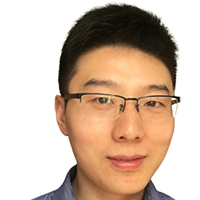He maps out urban activity and unequal living conditions in cities

Measuring urban forms and understanding how urban design can affect ways of living in the city are of great interest to Chen Feng, a postdoctoral fellow in Applied Urban Design. He is currently studying urban segregation and unequal living conditions in Swedish cities with Professor Ann Legeby.

Chen studied architecture in China, where he got interested in cities' street structures and how they affect human activities. During his masters' studies, he visited Macao and studied how the changes in its street structure had played a role in the migration of commercial centers. After that, he went to Georgia Tech in the US for his doctoral studies, where he worked with Professor John Peponis on urban design and space syntax.
– I started learning and applying theories and methods that show how the spatial structure of cities influences various kinds of urban activities as well as people’s perceptions of urban space. At Georgia Tech, I focused on developing methods and tools to generate and evaluate urban designs. Specifically, I designed and implemented computer algorithms to generate, analyze and sort thousands of street network patterns at the scale of a superblock.
Finding inequality through mapping
Based on his dissertation work, Chen Feng found that street networks can be differentiated along distinct pathways that entail different costs in terms of undesirable properties.
After Georgia Tech, Chen worked in Austin, Texas, expanded his interest in new urban technologies, and started to apply big data analytics and machine learning algorithms to study pressing issues related to urban mobility and urban health. He used a big data set from the city of Austin to map the use of e-scooters which can help the city plan micromobility infrastructure. He also used machine learning to predict neighborhood-scale health outcomes when it comes to chronic diseases like stroke, diabetes, and obesity.
– We can predict certain health outcomes and behaviors fairly accurately based on a set of socioeconomic variables by using machine learning algorithms. We also experimented with novel datasets which contributed to the predictive power of our models. For instance, we used 3-1-1 data—which lists the non-emergency issues reported by citizens to the local governments—to see how people perceive their neighborhood and how that ties to the health outcomes in American cities.
After living in China and the US, Chen was interested in experiencing living in Europe.
– I had never been to Sweden before, so it was very exciting for me to explore this beautiful country and its culture. As an urban researcher, I also appreciate the opportunity of working and living in Europe to see how cities here can look and feel differently from those in the US and China. I went to KTH because there was a strong interest here in space syntax.
The road that led to KTH
Chen Feng came to KTH because of his interest in measuring urban forms and studying how they interact with people’s activity patterns in cities. Together with Ann Legeby, he has mapped inequality and urban segregation in Uppsala.
– Counteracting segregation and creating more equal living conditions are important to achieving social sustainability. Issues related to segregation and inequality have drawn increasing attention in Sweden. In a project Ann and I did recently, we studied the unequal living conditions in the city of Uppsala by mapping the accessibility of basic services and facilities to people living in the different neighborhoods across the city.
Chen Feng has always been interested in cities and looking at them through an interdisciplinary lens.
– Cities are fascinatingly complex objects. It is not just the engineering part that is interesting. Equally interesting are the social and cultural aspects of cities. I got interested in space syntax largely because it offers theories and methods to help understand those aspects. I believe that to understand something as complex as cities, one should always be open-minded and ready to draw on knowledge from multiple disciplines.
Studying structures as a connected network
Chen Feng describes space syntax theory as a way to understand the spatial structure of buildings and cities as a network or a graph in mathematics. Even if only one connection in the network is changed, it can influence all the other parts of the network. Therefore, a seemingly localized design move can have an impact on the potential usage pattern of space at a much larger scale.
When asked what Chen Feng thinks are the most important contributions of his research field he returns to the humanization of numbers.
– In Geography, how far or near a place is from another is typically measured based on Euclidean distance, using units such as meters. In space syntax, we found that people perceive the distance between locations not just in terms of the physical effort but also the complexity of the path involved, for example how many turns to take. The idea of “configuration” is another important contribution, which defines the relationship between two spaces from the point of view of a third space.
Some spaces built to disconnect
Chen also points out that some places are made to not connect different places but to cut some people off. He further discusses the importance of creating urban spaces that are well connected and accessible to people with different backgrounds.
– In my current research group (Urban Design and Urban Theory) at KTH Architecture, my colleagues have been studying how to better integrate people with different social backgrounds and from different areas in the city. Creating urban spaces where diverse groups of people can easily meet and interact is important. Those places can offer opportunities to see people from all walks of life and to hear different voices and opinions.
In the future, Chen Feng hopes to stick to the field as it intersects urban design, informatics, and science with a strong focus on sustainability.
– As a researcher, I am interested in studying how urban design can contribute to a more resilient future. During an urban crisis such as the ongoing pandemic, people’s lives can be drastically changed. In many countries, there are stricter restrictions than in Sweden, and people are contained in a certain area and not allowed to travel. It is thus important to think about how we can design and plan cities to help people better cope with such kinds of crises.
Lessons from a crisis
During the pandemic, Chen’s colleagues at the University of Gävle used data to study how people closer to green spaces found that helped them cope with the urban crisis.
– KTH was also partly involved in that piece of research. It showed that people need secluded places to enjoy nature, do activities, avoid the crowd, and keep healthy. I think my colleagues' study shows that while compact urban development is very often promoted, we should not forget the importance of introducing open green spaces in cities. That is a good lesson for urban design from the pandemic. Even more importantly, these spaces need to be distributed in an equal manner and not just focus on certain areas, says Chen and continues:
– Currently, at the Senseable Stockholm Lab, Ann and I, along with our colleague Daniel Koch here at KTH Architecture, are collaborating with the City of Stockholm and MIT on a project in which we study how people have changed their habits of using urban spaces during the pandemic based on mobile phone data and online surveys. Insights gained from this study can suggest ways of enhancing urban resilience from an urban design perspective, Chen Feng concludes.
Text: Hanna Kalla
This is the 25th article in the School of Architecture and the Built Environment 's series of articles on selected research, education or collaboration initiatives from each department. You can find the previous articles here: Archive
